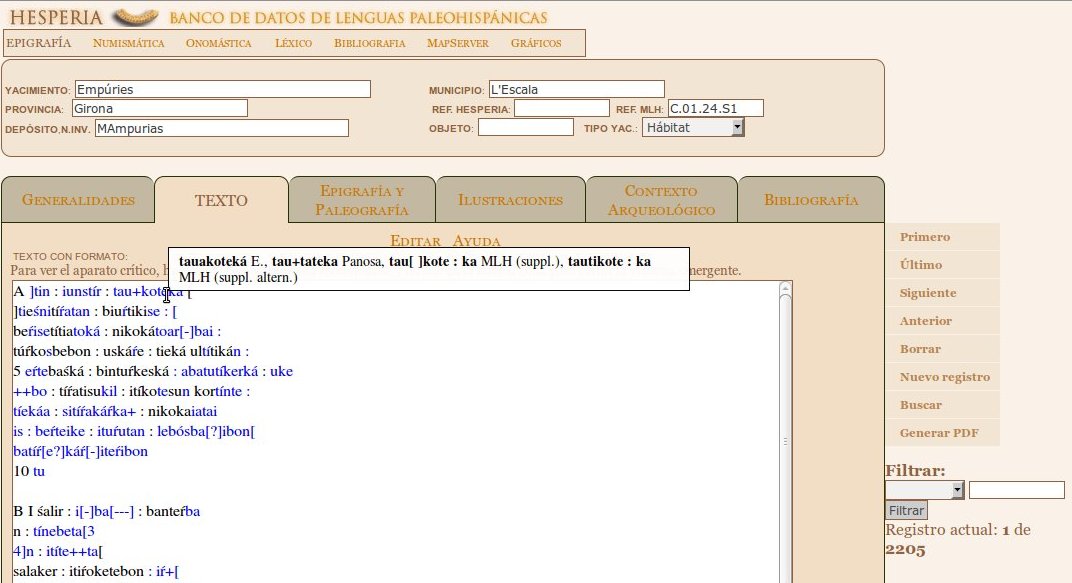Epigraphy
An external view of an epigraphic page (click to enlarge):

Palaeohispanic Epigraphy makes up the bulk of the HESPERIA Palaeohispanic Database. In this section all the inscriptions written in Palaeohispanic languages are collected and edited.
The database is organised in pages, in which each inscription corresponds to a different page. In order to better distribute the content, each page is organised further into six tabs: "General Features", "Text and Critical Apparatus", "Epigraphy and Palaeography", "Illustrations", "Archaeological Context" and "Bibliography".
At the top of each page there is a clear heading with the key information needed to identify the inscription. The “Hesperia Reference” provides the identification number of the inscription within the Hesperia database. This reference is created in the following way. Firstly, the capital letters indicate the abbreviation of the Spanish province (two letters), Portuguese province, or French département (three letters) where the inscription was found. Next appears the number of the findspot, followed by the number of the individual inscription. In instances where there are more than one inscription on the same epigraphic support, these are identified by letters a,b,c etc. In cases where its place of origin is unknown, the initials SP are used. The MLH Reference field notes whether the inscription is included in corpus Monumenta Linguarum Hispanicarum by J. Untermann or that the author noted it in the unpublished supplement (followed by SUP).
The "General Features" tab offers information about the epigraphic support and the physical features of the inscription.
In the "Text and Critical Apparatus" tab a system to easily visualise the critical apparatus has been developed. The text or text sequence with its script variants is highlighted in blue so that, by moving the mouse over it, a box appears with the script variants relating to that section. In order to transcribe the different languages a choice was made to use the most popular current systems employed by specialists: for Iberian, that used in the MLH by Untermann was followed, while for Celtiberian the preferred transliteration was that of Villar 1995. (see Scripts)
The "Epigraphy and Palaeography" tab includes epigraphic and linguistic information and comments, with the resulting interpretations, where appropriate. There are also observations of palaeographic interest. For Iberian inscriptions, the tab offers the possibility of accessing lexical comments by clicking on the “Lexical References” link. A box then appears in which the text of the inscription is repeated with the words or segments in blue. By moving the mouse over each of these, a box appears with the lexical entry and its corresponding commentary. The information offered is organised in three sections which are separated by a slash sign /: Next in the entry, the MLH reference and date are given first; then there is a short commentary on the entry; and finally, a brief relevant bibliography is provided.
The "Illustrations" tab provides access to the illustrations available.
The "Archaeological Context" tab contains all the information relating to the find spot, the dating of the inscription and any archaeological observations.
Finally, the "Bibliography" tab includes the references to the inscription, with special mention of the first edition of the inscription.
On the right-hand side of the page, there are buttons to help users move around inside the folder and look for any data that they may be interested in. On clicking “Search” a comprehensive search form appears in which they may fill out the fields into which they might want to group the inscriptions in the database. Once the request has been sent and a selection obtained, they will be able to generate a distribution map based on the selection or save the data in a PDF document. For more information, see “Search Help”.
All the content of the Epigraphic Database, including illustrations, are to be published in digital format divided into volumes and instalments according to the epigraphic region concerned. The volumes which are already edited can be found HERE.
© 2005 Departamento de Filología Griega y Lingüística Indoeuropea · Universidad Complutense de Madrid
License Data Bank last update: 2025-11-14 22:01:58